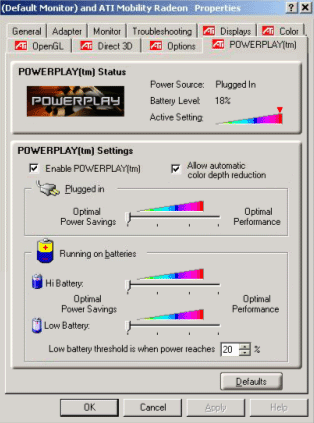ATI Mobility Radeon 9000: Raising the bar again
by Matthew Witheiler on August 29, 2002 5:00 AM EST- Posted in
- Laptops
POWERPLAY (continued)
Actual hardware is only one portion of ATI's POWERPLAY technology. The software employed by POWERPLAY is completely new for the third implementation of the technology and is leaps and bounds more robust than competing power management software.
When it comes to mobile GPU power management, we are used to seeing a single slider bar that controls the speed and perhaps voltage of the GPU. The settings altered on the slider typically only went into effect when the system was on battery power, leaving the video chip running at full speed the entire time it is given AC power and at the lesser, user defined maximum clock speed when ever the unit is on battery power. Although this method does get the job done, it is a somewhat brutish way of ensuring the desired battery performance of the notebook. ATI's new POWERPLAY software includes much more finesse.
Rather than keep the GPU performing at one set, user definable, maximum speed while on battery, ATI came up with a different approach. ATI's new POWERPLAY software allows the chip to dynamically clock itself at up to three different positions at two different points depending on battery life. For example, you could set a notebook with the Mobility Radeon 9000 to run the GPU at full clock speed and voltage when battery life is anywhere from 40% to 100% but at a one of two lower clock speeds when the battery life falls below this threshold. Since the low battery threshold is fully user customizable the chip can go to a lower speed at anywhere from 99% to 1% of battery life remaining.

The POWERPLAY software utility.
The user can also set the performance/power balance while on AC power but it clearly makes sense to leave this slider at optimal performance while plugged in.
Another feature that the new POWERPLAY driver tab offers is automatic color depth reduction. Decreasing color depth from 32-bit color to 16-bit color actually saves a small amount of power since the graphics chip has less information it needs to process. The automatic color depth reduction on the Mobility Radeon 9000 automatically reduces the color depth from 32-bit color to 16-bit color while on battery power. This results in a small decrease in power consumption for the chip but when it comes to power, any bit saved results in greater battery life.
We were very pleased to find such a powerful and easy to use user accessible implementation of POWERPLAY. The integration with the established driver base turned out great and settings are easy to find and adjust. In fact, the only problem with the software portion of POWERPLAY is not actually caused by ATI but rather by notebook manufacturers.
In the past we have seen very few notebook OEMs willing to implement driver based power management functions. Both the older Mobility Radeon 7500 and the current GeForce4 Go series chips include similar, although more basic, power management tools. Only a limited number of notebooks shipping with these chips actually implement the user controlled features of their power savings technology. Adoption rate for the user controlled power features is fairly low due in a large part to OEMs concerns with supporting yet another notebook feature. The last thing that a company like Dell, Compaq, or HP wants are users calling the support line because of a problem resulting from a user selectable slider
None of the notebooks that were unveiled at the launch event implemented the software portion of POWERPLAY. ATI assures us that we will see notebooks on the market that include this part of POWERPLAY. They stressed that the software implementation of POWERPLAY will come later in the product's cycle, as adding the software requires additional qualification to the production of a notebook. The notebooks launching today and in the next few months will likely not have the feature enabled, but come the end of the year ATI claims that we should see full implementations of POWERPLAY on the market. This puts the full implementation POWERPLAY technology around the time that Intel's new Banias processor hits the streets. We have to remain skeptical as we were assured the same thing with the Mobility Radeon 7500 and the NVIDIA GeForce4 Go chips as well.
Due to time constraints and testing limitations, we were unable to investigate how much of an impact POWERPLAY has on battery consumption. We hope to do a more in-depth article covering this topic in the coming weeks.










0 Comments
View All Comments